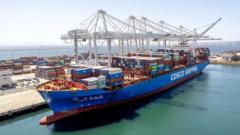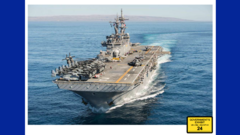As part of a strategy to revitalize the US shipbuilding sector, the Biden administration has announced that port fees will be imposed on Chinese vessels, with charges expected to rise significantly over the next three years. This move, though less severe than earlier proposals, raises concerns about further disruptions to global trade amidst ongoing tariff tensions with China.
US Plans Port Fees for Chinese Ships to Bolster Local Shipbuilding Industry

US Plans Port Fees for Chinese Ships to Bolster Local Shipbuilding Industry
The US administration outlines plans to impose fees on Chinese vessels to promote American shipbuilding and counter China's industrial dominance.
The Biden administration is set to implement new port fees on Chinese ships as part of an effort to enhance the competitiveness of the American shipbuilding industry and address China's growing dominance in the maritime sector. The US Trade Representative (USTR) has outlined that the fees will be introduced in approximately 180 days, and while the initial plan discussed in February suggested charges could reach $1.5 million for each entry into an American port, the final policy is notably milder.
The new fee structure will target Chinese vessel operators shipping goods to the US, with fees calculated based on cargo weight, container quantity, and vehicle count. Bulk vessels will face an initial charge of $50 per ton, increasing by $30 annually for three years. Container ships will be assessed starting at $18 a ton or $120 per container, similarly escalating over the same period. Additionally, non-US built ships delivering vehicles will incur a cost of $150 for each vehicle transported.
This strategy has raised alarms regarding potential disruptions to global trade dynamics, especially as tariffs already imposed by President Biden have reshaped trade flows. The USTR's statement emphasized that China has significantly disadvantaged US companies and workers, leading to these new measures.
Exempt from the fee structure are empty vessels arriving at US ports for exports like coal and grain, as well as US and Canadian ships operating exclusively in the Great Lakes and ships moving goods between American ports. Under phase two, anticipated to commence three years from now, preferences for US-built ships transporting liquefied natural gas will be implemented, progressively increasing over 22 years.
Amid these developments, trade experts warn that routes initially meant for US ports are being redirected to European destinations, raising concerns about future price inflation for American consumers. Notably, cargo destined for US ports from China has shifted toward Europe, according to trade groups, resulting in a roughly 15% rise in Chinese imports to the UK this year.
The tariffs imposed thus far have led to significant congestion in ports globally, particularly at major entry points like Felixstowe in the UK and Rotterdam in Europe. Experts assert this re-routing is a direct consequence of the Biden administration's tariff policies, causing further complications for global supply chains and raising potential costs for US consumers down the line.


















